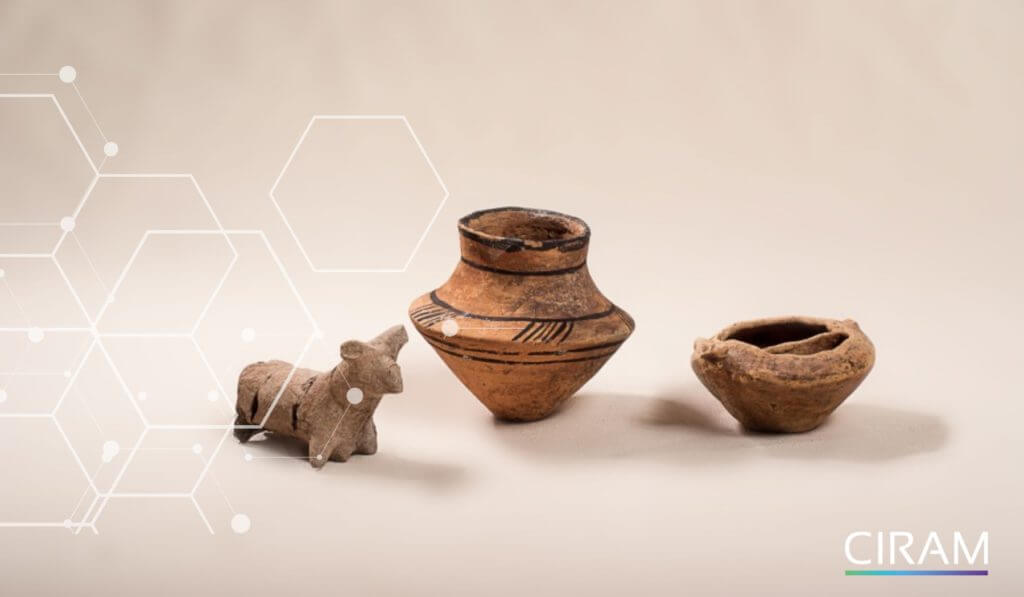Thermoluminescence test (TL test) on terracotta – CIRAM
The thermoluminescence test (TL test) is, along with carbon-14 dating, one of CIRAM’s specialties. This technique makes it possible to date the last heating of an object, but more precisely to detect authentic objects from modern fakes or copies.

Protocols, measurements or even interpretation of the results, discover the thermoluminescence test performed by CIRAM laboratories.
The thermoluminescence test in the laboratory
While dating materials is the most effective way to obtain a chronological marker to authenticate an art object, it is important to differentiate between the event that is dated and the event that we seek to date. Thus, dating a material is not the same as dating its use by humans.
Our scientists use carbon-14 dating for organic materials, but we also use other dating methods for inorganic materials. For heated objects, CIRAM uses thermoluminescence, which works on ceramics, porcelain, and all terracotta in general, with a chronological range of about 300,000 years.
Beware, materials such as stone, metal, glass, or even pigments, are not datable. CIRAM laboratories will use analytical alternatives (electron microscope, chemical analysis…) to authenticate them.
The phenomenon of luminescence
In 1664, Boyle reported the phenomenon of luminescence stimulated by a heat input or thermoluminescence (TL). But its physical properties were not studied until the 1930s with the development of photomultiplier tubes. In the 1950s, the potential of thermoluminescence was explored in the context of dating archaeological materials, particularly ceramics. But the application of TL to dating did not succeed until the mid-1960s in England. It was not until 1967 that the first TL dating work was carried out in France.
The principle of thermoluminescence
TL is based on the study of natural radioactivity and the ability of crystals contained in a terracotta to accumulate the effects of this irradiation. This energy (also called irradiation dose) is proportional to the time the crystals are subjected to this irradiation. In other words, the TL corresponds to the emission of light (phenomenon of luminescence) caused by a contribution of energy in thermal form (thermo). Note that the intensity of this luminescence is proportional to the energy absorbed by the crystal, thus proportional to time.
TL tests allow us to determine the natural irradiation dose (QNat) received since an instant zero (i.e., the last heating of the material). To perform a real TL dating, it is necessary to measure two values:
- QNat: real irradiation dose;
- I: annual irradiation dose.
The TL study of objects out of the context of burial does not allow a real dating. However, the measurement of QNat will assess the age and provide objective information on the authenticity or not of the object studied. For this, we will consider an annual radiation dose between 3 and 6 mGy/year, which corresponds to the vast majority of cases encountered. This lack of measurement of the annual dose induces that the relative accuracy of age tests by thermoluminescence is of the order of 20 to 30 e the estimated age.
Distinction between fake and authentic object
Through examination of thermoluminescence curves, it is possible to distinguish between modern fakes and authentic objects.
In contrast to carbon-14, it is impossible to detect a significant hiatus between the dated event and the event one is seeking to date. Since the firing of the clay is the last anthropogenic act recorded by the material. The relevance of the result to the problem posed leaves no room for doubt.
The thermoluminescence test
The TL test is relatively simple to perform, however the diversity of materials makes it complex to adapt measurement protocols and interpret the results. For example, porcelains are problematic in TL because their method of manufacture involves high-temperature firing that results in total or partial amorphization of the material. As a result, the physical properties that condition the operation of the TL are altered or even destroyed. In this case, the results of classical TL will be unusable and we will then use predose”, an alternative technique.
